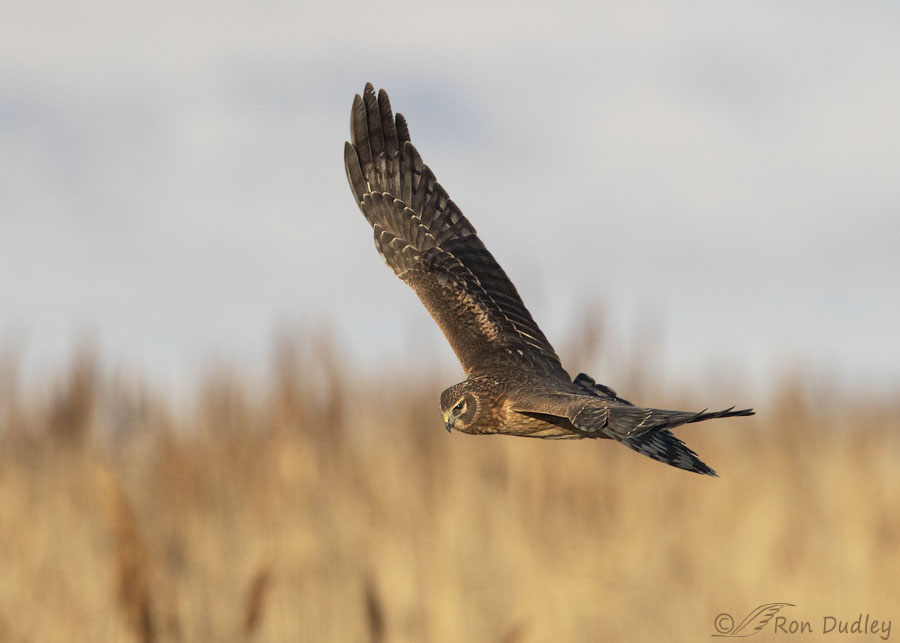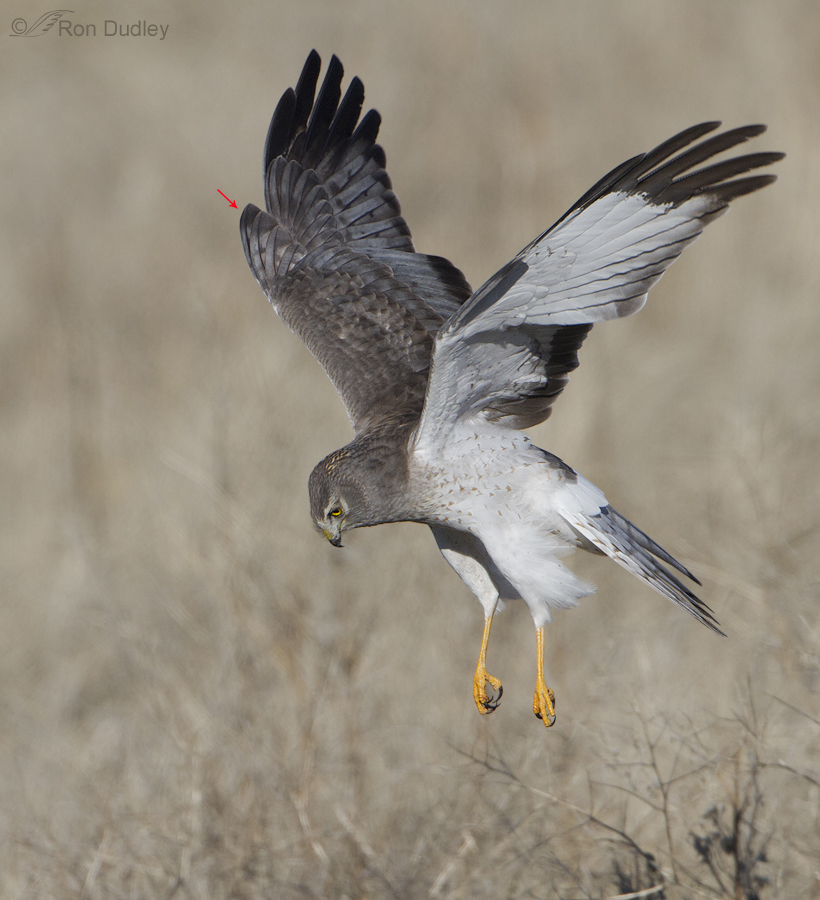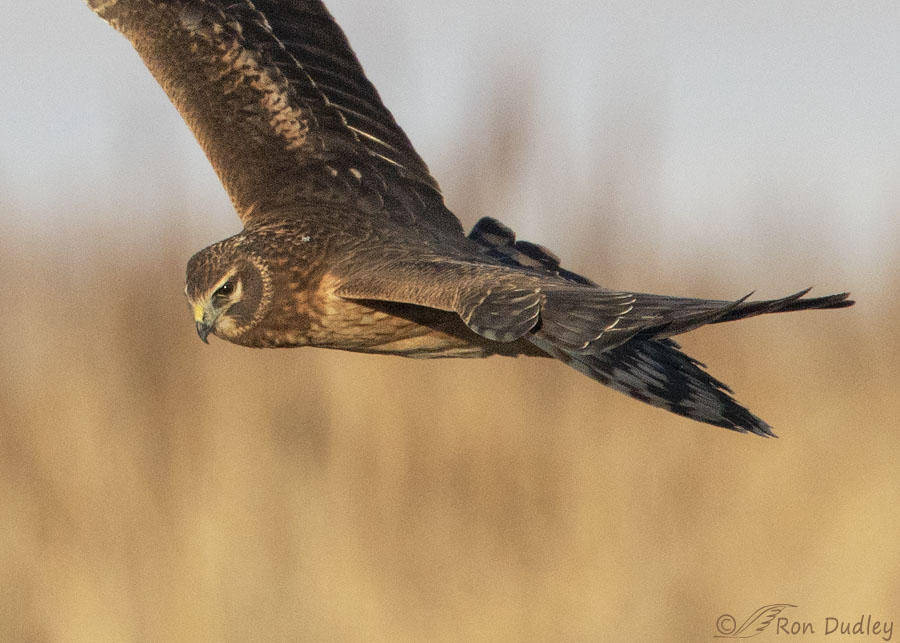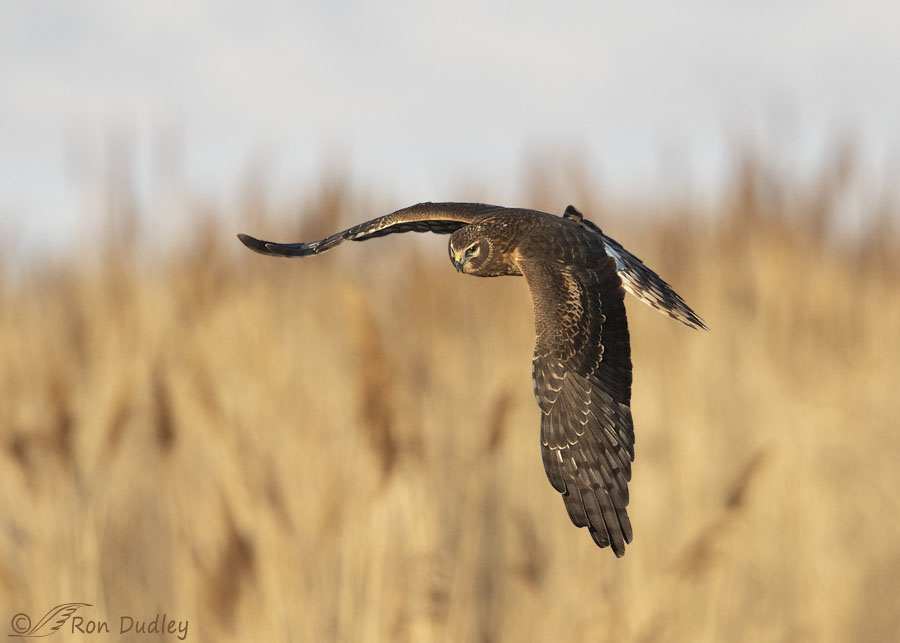I pay attention to the alulae in my photos of birds in flight and this one caught my eye.

1/8000, f/6.3, ISO 800, Canon 7D Mark II, Canon EF 500mm f/4L IS II USM + EF 1.4 III Extender, not baited, set up or called in
I photographed this Northern Harrier three weeks ago at Bear River MBR. She was hunting the phrag edges along one of the canals when I managed to get several sharp shots of her in a short burst. I posted some of them last month but this one is new to my blog.
Notice the shape and attack angle of the alula on her left wing. Typically the alulae (winglets or “bastard wings”) are held tightly against the leading edge of the wing and appear to be part of it, as we see with her right wing. When they’re extended forward (deployed) briefly during slow flight their function is to provide additional lift.
Usually they’re extended forward at the same attack angle as the wing (or very close to it) but this one appears to be dipped down at such a steep angle it would almost function as an air brake for that wing. And its shape seems to be somehow oddly different than I’ve seen in the past, more rounded and perhaps even slightly concave or saucer shaped instead of shaped like a typical air foil.

It isn’t unusual to have only one of the two alulae deployed as we see here with this hovering adult male Northern Harrier. This is the shape and attack angle of a deployed alula that I’m used to seeing.

Here’s a closer look at the female’s left alula in the first photo. Apparently it was only kept in this shape and at this attack angle for an instant because…

in the next shot in the burst one tenth of a second later it had returned to its “normal” shape, position and attack angle.
I hesitate to speculate about the reason for what I think I’m seeing in the first photo. It could be a number of things or I suppose it’s possible that I think I’m seeing something I’m not (though I really doubt that).
Perhaps it’s inconsequential but I noticed it so I had to point it out.
Ron


“A large bird landing on its nest
Adult bald eagle landing, showing the alula in action
In most situations, the alula is held flush against the wing; however, it can be manipulated. When flying at slow speeds or landing, the bird moves its alula slightly upwards and forward, which creates a small slot on the wing’s leading edge. This functions in the same way as the slats on the wing of an aircraft, allowing the wing to achieve a higher than normal angle of attack – and thus lift – without resulting in a stall.[1] The tip of the alula forms a tiny vortex that forces the airflow over the wing to better bind to it. [2][3] During stretching of the wing down toward the ground, the alula is abducted from the wing and can be clearly viewed.
In falcons, the alula is more prominent, and provides a degree of control when the wing is cupped or tucked in a dive/stoop. The Alulae are particularly notable in peregrine falcons.”
I’ve added the quotes to Deena’s comment above because it’s a direct quote from Wikipedia.
It may be an illusion, but it seems that the allula-of-interest is deployed at the same angle as the tail is tilted. These are gorgeous shots!
Thank you, Marty.
Awesome series Ron!!!
Charlotte
Thanks, Charlotte.
Colour me clueless – but intrigued.
Thanks teach.
You’re very welcome, EC.
Aerodynamic engineers wouldn’t exist if there were no birds. They watch with green envy as hummingbirds and condors perform maneuvers which should be impossible. Lab trash bins are littered with diagrams of what didn’t work for humans.
I am the opposite of an engineer. I marvel at nature but make no coherent attempt to explain or duplicate it. I did, however, in a former life, work closely with folks who aspired to be birds and became combat pilots. I learned a bit by osmosis. I think you’ve nailed the reason for the apparent unusual position of the left wing alula: “… it would almost function as an air brake for that wing.” Likely, she was about to make a pivot or dive. Your next shot (one-tenth of second later) suggests she changed her mind (or achieved a slightly different look at a potential target).
Not sure how to explain the difference in appearance from previous observations. One of the many reasons I simply like watching birds!
Fascinating post and superb photography, yet again! We are spoiled.
I’m glad you enjoyed the post, Wally. And yes, engineers often model their new “contraptions” after birds.
Now I will start looking for details like this. I learn a lot here. thanks!
Took shots of several harriers and kites yesterday, will review, especially the kites..
Thank you, Martha.
Ron lovely shots! On the first image of the adult male the shadow of the alula on the near wing indicates to me that it is also being brought well forward of the wings edge. Though not possible to see directly at this angle the shadow shows the forward positioning. The alula is often thought of as a stall preventer for high angle low speed air. In this hover I think it is simply being used for extra wing area as the bird appears to be in a momentary strong hover/braking effort trying to zero in on a prey item it heard or saw below almost behind. Harriers for all their ferocity in the air are mostly feathers and air. Incredibly light for their size. Most raptors as they scale larger from species to species get heavier wing loading as the size rises in a given chasis for instance from sharpie to coops to gos this is true. Our harrier has an incredibly light wing loading for its size roughly equivalent to the wing loading of the much smaller sharpie. This light wing loading allows both species to fly at much slower speeds and probably out climb other species when soaring.
You’re probably right about the right wing alula of the male, Steven.
And your assessment of the ratio of weight to overall size of harriers is spot on.
Gathered some of the initial wing area/loading data while banding at Cape May 40- years ago.
Steven, Tomorrow I’m posting a shot that I took just this morning that shows the incredible relative wing length and surface area of a harrier better then any other harrier photo I’ve taken. And I’ve taken a LOT of them.
Boy, you have the eye for detail of a scientist. Was it a windy day? Is it possible that the alula and the adjacent greater primary coverts are deformed by air current? It just strikes me as an external deformation rather than an intentional manipulation by the Harrier.
Nope, no wind that day, Lyle – not that I remember and I tend to remember wind. I suppose what you suggest is possible.
Outstanding photos as always Ron. Unfortunately I have never gotten in-flight photos of my elusive Harrier that are good enough to notice the alulae, but I will keep trying. Thanks for the aerodynamics lesson.
Thank you, Everett.
Great shots, specially the 2nd one. And thanks for adding a new Latin word to my vocabulary (and i thought those were just reserved for Medical students).
Elmer, one of the great mistakes I made in my own formal education was never taking a Latin class. As a biologist I regretted it for my entire career.
Hi Ron,
I find that I’m constantly learning from my own photos; birds and other subjects. I often wonder how/if science is being advanced by analyzing burst photos and video footage of subjects that they were not really able to study from a distance prior to our current digital revolution. Oh well, I love your pics and your analysis of the Northern Harrier. I learn many things from your blog. Thanks!
Rick
Thank you, Rick. I strongly suspect that the digital revolution has provided many extremely useful tools to science.
Next row of feathers also seems be be “concave” a bet and the edge of the wing rolled down maybe so all working together for the turn? It is a different than usual. Always something a bit different to observe/learn….. 🙂 Beautiful bird….. -11 this morning don’t know the wind chill but barely a breeze……..
It’s cold here too, Judy but not nearly that cold (+22). Our high is supposed to be 41.
The edge of the wing and the alula seem to bee lined up at the same angle. That must help in some kind of move she was contemplating.
Not having the knowledge you have, could it be just a directional move, quicker turn, able to get prey faster. Just a thought from a pure novice.
Yes, I think that’s possible, Steve. If that unusual looking alula was functioning as an air brake the result would be a turn to the bird’s left. But I’ve never heard or read about alulae functioning as air brakes or turning aids. As far as I knew their only function is to provide additional lift.
‘The devil is in the details’….I’m glad we have you to point these things out to us. Until I started reading your blog, such things may have caught my eye but I’m sure I wouldn’t have an inkling as to reason or purpose. Thanks many times over for helping me along the way with posts as such. I walk away always going back to check out my photos and learn from them!
“I walk away always going back to check out my photos and learn from them”
It took me a while to learn that lesson but now it’s something I nearly always do. Thanks, Kathy.